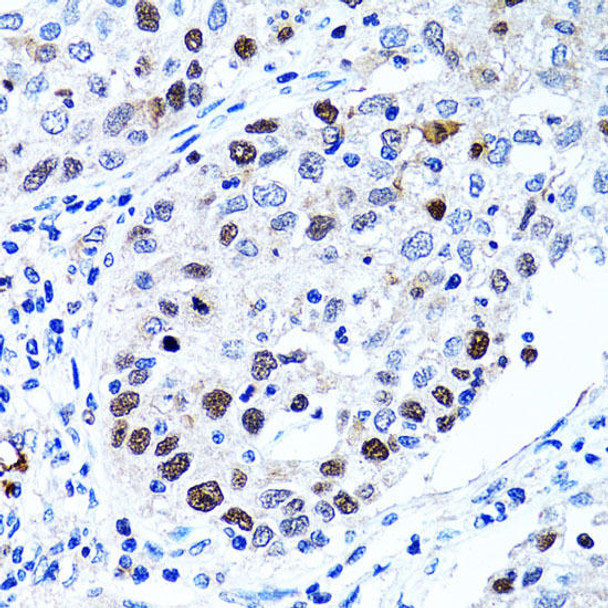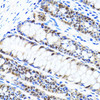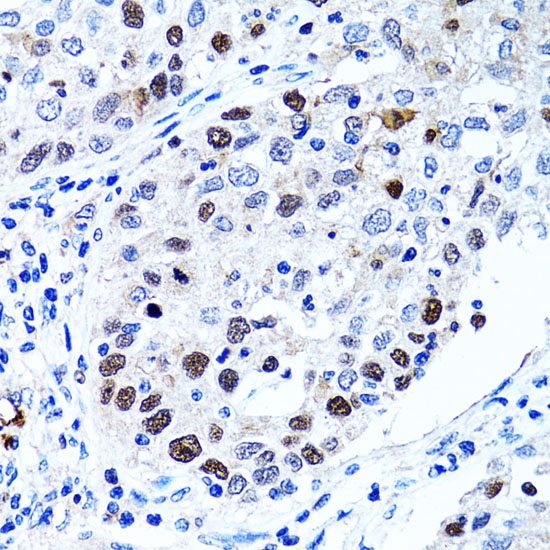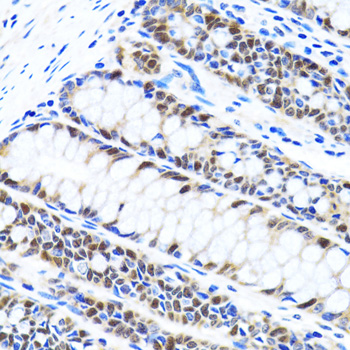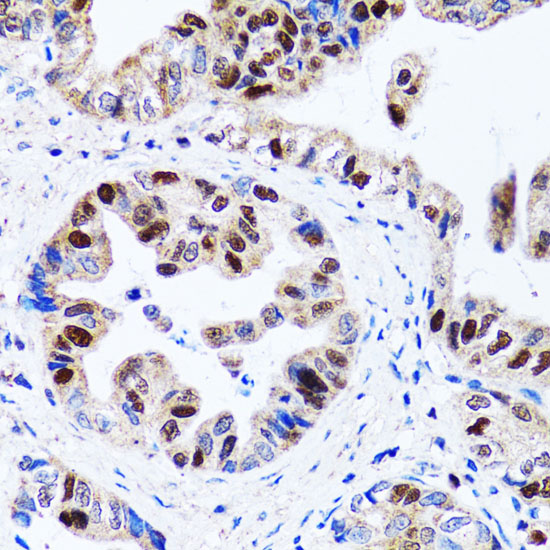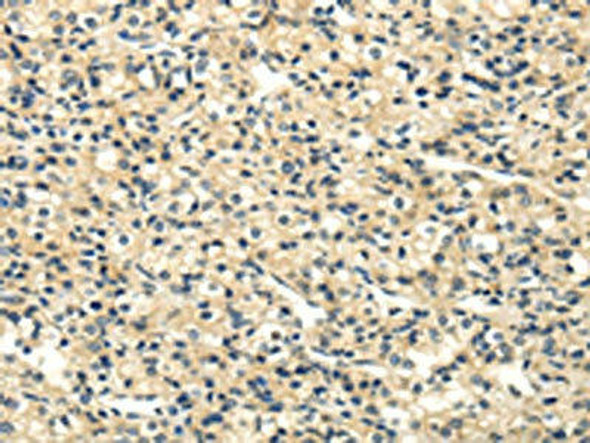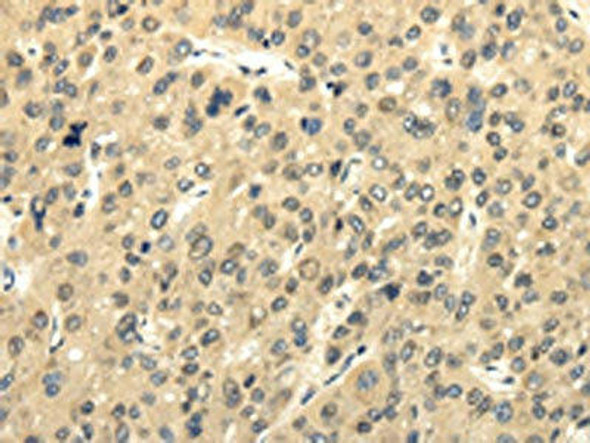Anti-UHRF1 Antibody (CAB2343)
- SKU:
- CAB2343
- Product Type:
- Antibody
- Reactivity:
- Human
- Host Species:
- Rabbit
- Isotype:
- IgG
- Research Area:
- Cell Cycle
Description
Anti-UHRF1 Antibody (CAB2343)
The UHRF1 Polyclonal Antibody (CAB2343) is a valuable tool for researchers studying the UHRF1 protein, which plays a crucial role in epigenetic regulation and cell cycle progression. This polyclonal antibody, developed in rabbits, exhibits high specificity towards human samples and has been validated for use in Western blot applications.UHRF1 is known for its involvement in DNA methylation, histone modification, and chromatin remodeling, making it a key player in gene expression and cellular differentiation. Dysregulation of UHRF1 has been linked to various diseases, including cancer and developmental disorders, highlighting the importance of studying its function and regulation.
By using the UHRF1 Polyclonal Antibody, researchers can accurately detect and analyze the expression levels of UHRF1 in different cell types and experimental conditions. This antibody is a valuable tool for exploring the role of UHRF1 in epigenetic regulation, cell proliferation, and disease development, making it essential for studies in molecular biology, cancer research, and epigenetics.
| Antibody Name: | Anti-UHRF1 Antibody |
| Antibody SKU: | CAB2343 |
| Antibody Size: | 20uL, 50uL, 100uL |
| Application: | WB IHC IF |
| Reactivity: | Human |
| Host Species: | Rabbit |
| Immunogen: | Recombinant fusion protein containing a sequence corresponding to amino acids 1-260 of human UHRF1 (NP_001041666.1). |
| Application: | WB IHC IF |
| Recommended Dilution: | WB 1:500 - 1:2000 IHC 1:50 - 1:200 IF 1:20 - 1:50 |
| Reactivity: | Human |
| Positive Samples: | THP-1, HeLa, SW480, MCF7 |
| Immunogen: | Recombinant fusion protein containing a sequence corresponding to amino acids 1-260 of human UHRF1 (NP_001041666.1). |
| Purification Method: | Affinity purification |
| Storage Buffer: | Store at -20'C. Avoid freeze / thaw cycles. Buffer: PBS with 0.02% sodium azide, 50% glycerol, pH7.3. |
| Isotype: | IgG |
| Sequence: | MWIQ VRTM DGRQ THTV DSLS RLTK VEEL RRKI QELF HVEP GLQR LFYR GKQM EDGH TLFD YEVR LNDT IQLL VRQS LVLP HSTK ERDS ELSD TDSG CCLG QSES DKSS THGE AAAE TDSR PADE DMWD ETEL GLYK VNEY VDAR DTNM GAWF EAQV VRVT RKAP SRDE PCSS TSRP ALEE DVIY HVKY DDYP ENGV VQMN SRDV RARA RTII KWQD LEVG QVVM LNYN PDNP KERG FWYD AEIS RKRE TRTA RELY ANVV |
| Gene ID: | 29128 |
| Uniprot: | Q96T88 |
| Cellular Location: | Nucleus |
| Calculated MW: | 89kDa/91kDa |
| Observed MW: | 110kDa |
| Synonyms: | UHRF1, ICBP90, Np95, RNF106, TDRD22, hNP95, hUHRF1, huNp95 |
| Background: | This gene encodes a member of a subfamily of RING-finger type E3 ubiquitin ligases. The protein binds to specific DNA sequences, and recruits a histone deacetylase to regulate gene expression. Its expression peaks at late G1 phase and continues during G2 and M phases of the cell cycle. It plays a major role in the G1/S transition by regulating topoisomerase IIalpha and retinoblastoma gene expression, and functions in the p53-dependent DNA damage checkpoint. It is regarded as a hub protein for the integration of epigenetic information. This gene is up-regulated in various cancers, and it is therefore considered to be a therapeutic target. Multiple transcript variants encoding different isoforms have been found for this gene. A related pseudogene exists on chromosome 12. |
| UniProt Protein Function: | UHRF1: Multidomain protein that acts as a key epigenetic regulator by bridging DNA methylation and chromatin modification. Specifically recognizes and binds hemimethylated DNA at replication forks via its YDG domain and recruits DNMT1 methyltransferase to ensure faithful propagation of the DNA methylation patterns through DNA replication. In addition to its role in maintenance of DNA methylation, also plays a key role in chromatin modification: through its tudor-like regions and PHD- type zinc fingers, specifically recognizes and binds histone H3 trimethylated at 'Lys-9' (H3K9me3) and unmethylated at 'Arg-2' (H3R2me0), respectively, and recruits chromatin proteins. Enriched in pericentric heterochromatin where it recruits different chromatin modifiers required for this chromatin replication. Also localizes to euchromatic regions where it negatively regulates transcription possibly by impacting DNA methylation and histone modifications. Has E3 ubiquitin-protein ligase activity by mediating the ubiquitination of target proteins such as histone H3 and PML. It is still unclear how E3 ubiquitin-protein ligase activity is related to its role in chromatin in vivo. May be involved in DNA repair. Defects in UHRF1 may be a cause of cancers. Overexpressed in many different forms of human cancers, including bladder, breast, cervical, colorectal and prostate cancers, as well as pancreatic adenocarcinomas, rhabdomyosarcomas and gliomas. Plays an important role in the correlation of histone modification and gene silencing in cancer progression. Expression is associated with a poor prognosis in patients with various cancers, suggesting that it participates in cancer progression. 2 isoforms of the human protein are produced by alternative splicing. |
| UniProt Protein Details: | Protein type:DNA-binding; Ligase; Ubiquitin conjugating system; Ubiquitin ligase; EC 6.3.2.-; EC 6.3.2.19; Transcription factor Chromosomal Location of Human Ortholog: 19p13.3 Cellular Component: euchromatin; heterochromatin; nuclear chromatin; nuclear heterochromatin; nuclear matrix; nucleus; replication fork Molecular Function:histone binding; identical protein binding; methyl-CpG binding; methylated histone residue binding; nucleosomal histone binding; protein binding; transcription factor activity; ubiquitin-protein ligase activity; zinc ion binding Biological Process: cell proliferation; histone monoubiquitination; histone ubiquitination; maintenance of DNA methylation; negative regulation of transcription from RNA polymerase II promoter; positive regulation of cellular protein metabolic process; positive regulation of transcription from RNA polymerase II promoter; protein autoubiquitination; protein ubiquitination during ubiquitin-dependent protein catabolic process |
| NCBI Summary: | This gene encodes a member of a subfamily of RING-finger type E3 ubiquitin ligases. The protein binds to specific DNA sequences, and recruits a histone deacetylase to regulate gene expression. Its expression peaks at late G1 phase and continues during G2 and M phases of the cell cycle. It plays a major role in the G1/S transition by regulating topoisomerase IIalpha and retinoblastoma gene expression, and functions in the p53-dependent DNA damage checkpoint. It is regarded as a hub protein for the integration of epigenetic information. This gene is up-regulated in various cancers, and it is therefore considered to be a therapeutic target. Multiple transcript variants encoding different isoforms have been found for this gene. A related pseudogene exists on chromosome 12. [provided by RefSeq, Feb 2014] |
| UniProt Code: | Q96T88 |
| NCBI GenInfo Identifier: | 67462077 |
| NCBI Gene ID: | 29128 |
| NCBI Accession: | Q96T88.1 |
| UniProt Secondary Accession: | Q96T88,Q2HIX7, Q8J022, Q9H6S6, Q9P115, Q9P1U7, A0JBR2 A8K024, B2RBA9, |
| UniProt Related Accession: | Q96T88 |
| Molecular Weight: | 91,116 Da |
| NCBI Full Name: | E3 ubiquitin-protein ligase UHRF1 |
| NCBI Synonym Full Names: | ubiquitin like with PHD and ring finger domains 1 |
| NCBI Official Symbol: | UHRF1 |
| NCBI Official Synonym Symbols: | Np95; hNP95; ICBP90; RNF106; TDRD22; hUHRF1; huNp95 |
| NCBI Protein Information: | E3 ubiquitin-protein ligase UHRF1 |
| UniProt Protein Name: | E3 ubiquitin-protein ligase UHRF1 |
| UniProt Synonym Protein Names: | Inverted CCAAT box-binding protein of 90 kDa; Nuclear protein 95; Nuclear zinc finger protein Np95; HuNp95; hNp95; RING finger protein 106; Transcription factor ICBP90; Ubiquitin-like PHD and RING finger domain-containing protein 1; hUHRF1; Ubiquitin-like-containing PHD and RING finger domains protein 1 |
| Protein Family: | UHRF1-binding protein |
| UniProt Gene Name: | UHRF1 |
| UniProt Entry Name: | UHRF1_HUMAN |


